

Nuclear Attack on Japan was Opposed by American Military Leadership - Gar Alperovitz: Nuclear Attack on Japan was Opposed by American Military Leadership - Gar Alperovitz: President Truman used the A-bomb to make a "diplomatic" point to the Soviet Union, not out of military necessity.
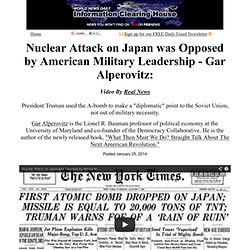
PAUL JAY, SENIOR EDITOR, TRNN: Welcome back to The Real News Network. I'm Paul Jay in Baltimore. Now, this series is going to be primarily about America after capitalism, which is a book that Gar wrote, and we're going to take a look at what his thinking is on that. But Gar, as we learned from part one--and if you haven't watched part one, you should--he wrote a PhD thesis and then a book that led to a whole reopening of the debate or discussion about just why America dropped the nuclear bomb that ended the war with Japan after World War II. So thanks for joining us again, Gar. GAR ALPEROVITZ, COFOUNDER, DEMOCRACY COLLABORATIVE: Thanks for having me. JAY: And one more time, Gar is the Lionel R. So thanks for joining us again. ALPEROVITZ: Thank you. JAY: So let's jump to the chase about the bomb. Nukleární zbraně. Nuclear weapons. Pro- nuclear weapons. Atomic bombings of Hiroshima and Nagasaki - Curiyo.com. America’s Nuclear Arsenal: Towards a New “More Efficient” “High Precision” Nuclear Bomb.
The idea of fighter jets taking off from Western Europe, thundering their way eastwards and dropping nuclear bombs on Soviet troops is a scenario taken straight out of the Cold War playbook.
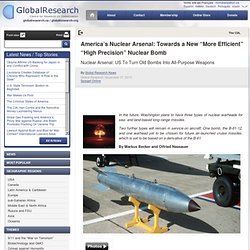
But while that playbook has long been outdated, American nuclear bombs are still stationed in Europe. In Germany alone, up to 20 B-61 weapons are stored on a German airbase in the village of Büchel in Rhineland-Palatinate. The German government has said on numerous occasions it would like to see those weapons removed, but there is no great chance of that happening anytime soon. Instead, the weapons are expected to be upgraded with enhanced military capabilities.Last week, representatives of the US military, the Pentagon and the Department of Energy announced new details about the B-61 program in a hearing in the House Armed Services Committee’s Subcommittee on Strategic Forces.
The first B-61-12 is expected to be completed by 2020. The US military has high expectations for “System 2″.
Jaderná zbraň. Jaderná zbraň nebo též atomová zbraň je zbraň hromadného ničení, založená na principu neřízené řetězové reakce jader těžkých prvků.
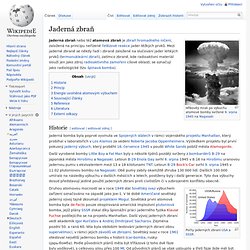
Mezi jaderné zbraně se někdy řadí i zbraně založené na slučování jader lehkých prvků (termonukleární zbraň), zatímco zbraně, kde radioaktivní materiál slouží jen jako zdroj radioaktivního zamoření cílové oblasti, se označují jako radiologické (tzv. špinavá bomba). Historie[editovat | editovat zdroj] Jaderná bomba byla poprvé vyvinuta ve Spojených státech v rámci vojenského projektu Manhattan, který probíhal v laboratořích v Los Alamos za vedení Roberta Jacoba Oppenheimera. Výsledkem projektu byl první pokusný jaderný výbuch, který proběhl 16. července 1945 v poušti White Sands poblíž města Alamogordo. Další vyrobené bomby Little Boy a Fat Man byly o několik týdnů později svrženy z bombardérů B-29 na japonská města Hirošimu a Nagasaki. Druhou atomovou mocností se v roce 1949 stal Sovětský svaz výbuchem zařízení označováno na západě jako Joe-1. Princip činnosti. Nuclear weapon - Curiyo.com. Nuclear weapon. Nuclear weapons testing. Nuclear weapons tests are experiments carried out to determine the effectiveness, yield, and explosive capability of nuclear weapons.

Treaty on the Non-Proliferation of Nuclear Weapons. The Treaty on the Non-Proliferation of Nuclear Weapons, commonly known as the Non-Proliferation Treaty or NPT, is an international treaty whose objective is to prevent the spread of nuclear weapons and weapons technology, to promote cooperation in the peaceful uses of nuclear energy and to further the goal of achieving nuclear disarmament and general and complete disarmament.[1] Opened for signature in 1968, the Treaty entered into force in 1970.
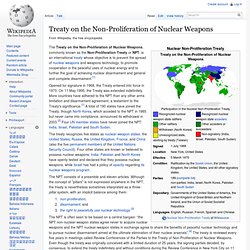
On 11 May 1995, the Treaty was extended indefinitely. More countries have adhered to the NPT than any other arms limitation and disarmament agreement, a testament to the Treaty's significance.[1] A total of 190 states have joined the Treaty, though North Korea, which acceded to the NPT in 1985 but never came into compliance, announced its withdrawal in 2003.[2] Four UN member states have never joined the NPT: India, Israel, Pakistan and South Sudan. The NPT consists of a preamble and eleven articles. Treaty "pillars"[edit] Key articles[edit] 2. After the Iran deal, who next for nuclear disarmament? The nuclear deal between Iran and the US is rightly hailed as a historic development – a vindication of the diplomatic path and a step away from the war that has been mooted against Iran for a decade.
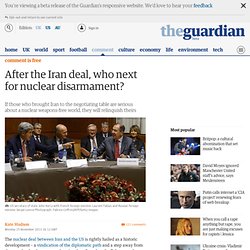
Taken together with the recent IAEA agreement with Iran, it will, as Barack Obama puts it, "cut off Iran's most likely paths to a bomb". No doubt the agreement will be held up as evidence of Obama's much-trumpeted commitment to a nuclear weapons-free world. And of course, non-proliferation initiatives like this are an essential part of that process.